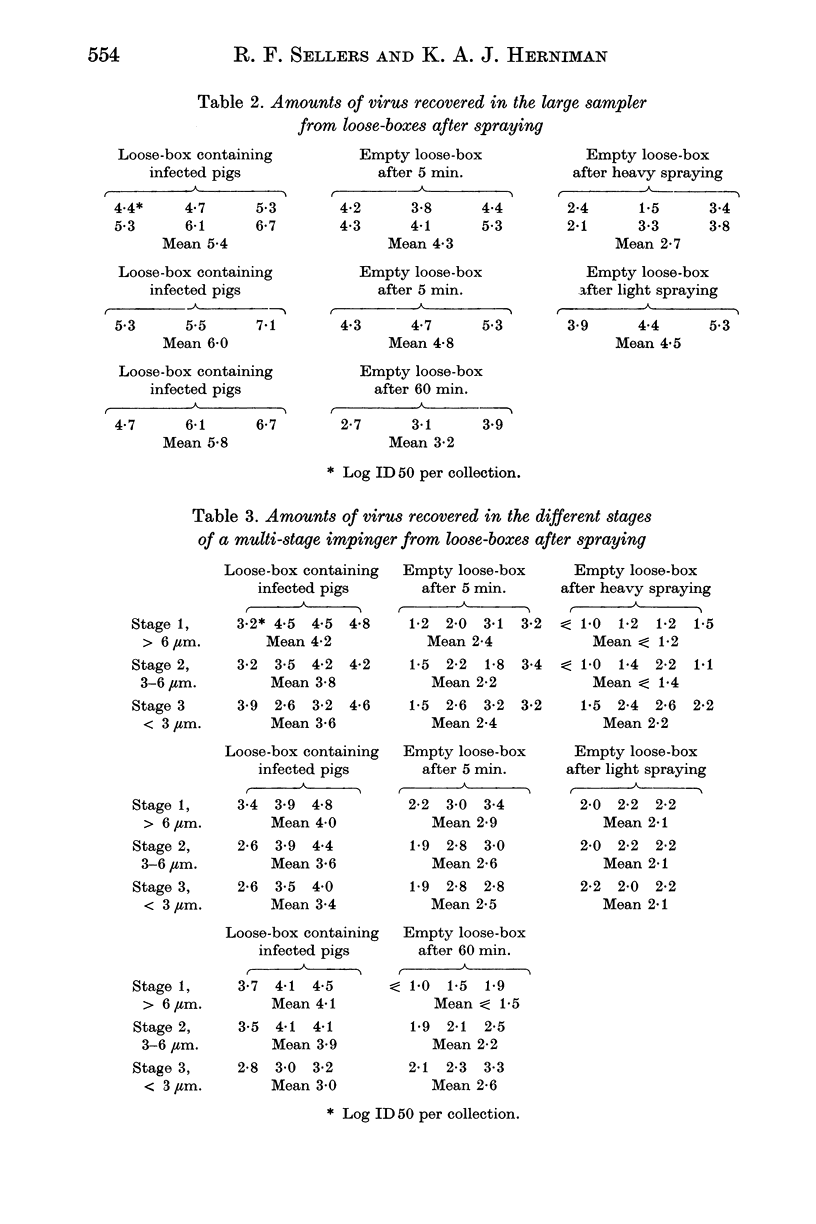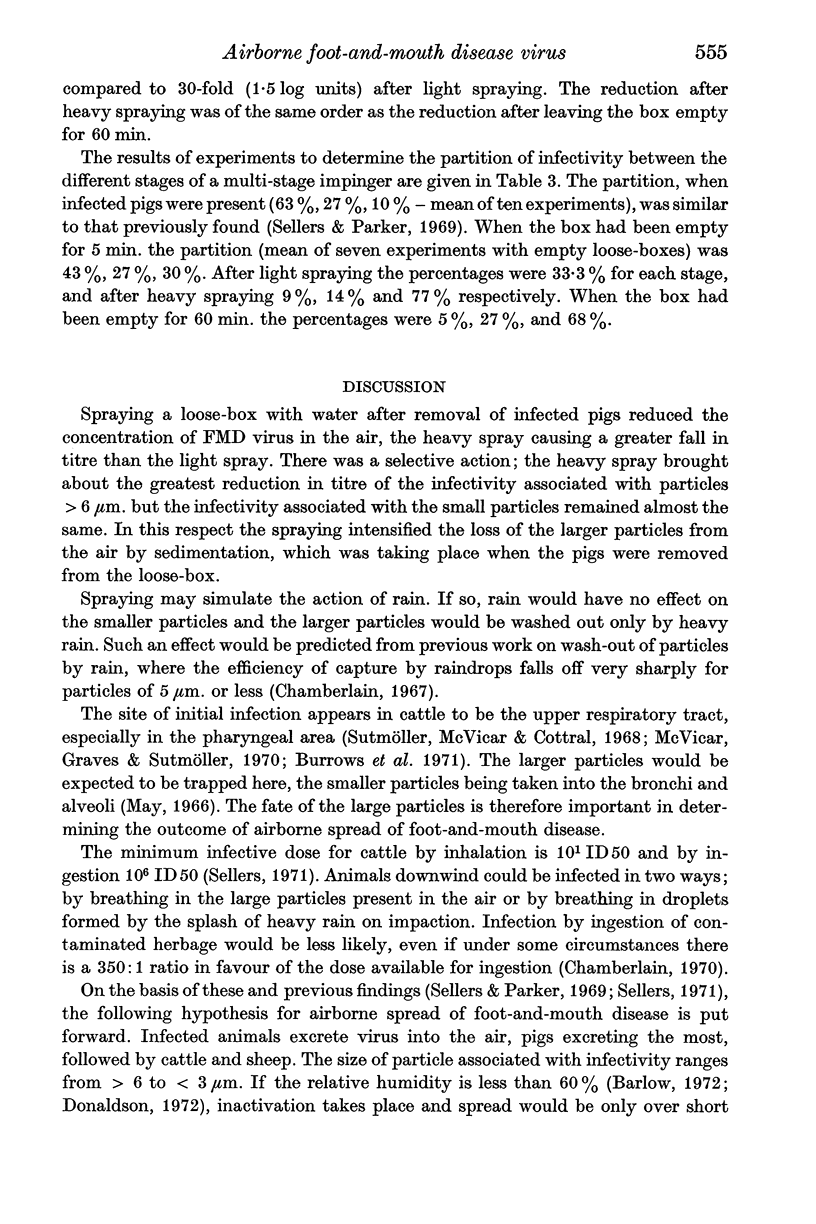Abstract
The air of loose-boxes which had previously held pigs infected with foot-and-mouth disease was sampled for virus after various procedures. Removal of infected pigs led to a 12- to 16-fold reduction in the amount of virus after 5 min. and a 400-fold reduction after 60 min. After heavy spraying (1·2 mm. of water in 5 min.) the amount of virus was reduced 500-fold compared to 30-fold after light spraying (0·20 mm. of water in 5 min.). The partition of infectivity associated with particle size was measured. The partition found after light spraying was similar to that found 5 min. after the pigs had been removed. Heavy spraying brought about a reduction in the infectivity associated with the large particles (> 6 μm.) but had no effect on particles less than 3 μm. A similar partition was found 60 min. after the pigs had been removed. The findings are discussed in relation to the spread of foot-and-mouth disease by the airborne route.
Full text
PDF





Selected References
These references are in PubMed. This may not be the complete list of references from this article.
- Barlow D. F. The aerosol stability of a strain of foot-and-mouth disease virus and the effects on stability of precipitation with ammonium sulphate, methanol or polyethylene glycol. J Gen Virol. 1972 Apr;15(1):17–24. doi: 10.1099/0022-1317-15-1-17. [DOI] [PubMed] [Google Scholar]
- Burrows R., Mann J. A., Greig A., Chapman W. G., Goodridge D. The growth and persistence of foot-and-mouth disease virus in the bovine mammary gland. J Hyg (Lond) 1971 Jun;69(2):307–321. doi: 10.1017/s0022172400021537. [DOI] [PMC free article] [PubMed] [Google Scholar]
- Chamberlain A. C. Deposition and uptake by cattle of airborn particles. Nature. 1970 Jan 3;225(5227):99–100. doi: 10.1038/225099a0. [DOI] [PubMed] [Google Scholar]
- Donaldson A. I. The influence of relative humidity on the aerosol stability of different strains of foot-and-mouth disease virus suspended in saliva. J Gen Virol. 1972 Apr;15(1):25–33. doi: 10.1099/0022-1317-15-1-25. [DOI] [PubMed] [Google Scholar]
- May K. R. Multistage liquid impinger. Bacteriol Rev. 1966 Sep;30(3):559–570. doi: 10.1128/br.30.3.559-570.1966. [DOI] [PMC free article] [PubMed] [Google Scholar]
- Norris K. P., Harper G. J. Windborne dispersal of foot and mouth virus. Nature. 1970 Jan 3;225(5227):98–99. doi: 10.1038/225098a0. [DOI] [PubMed] [Google Scholar]
- Sellers R. F., Herniman K. A., Donaldson A. I. The effects of killing or removal of animals affected with foot-and-mouth disease on the amounts of airborne virus present in looseboxes. Br Vet J. 1971 Aug;127(8):358–365. doi: 10.1016/s0007-1935(17)37440-7. [DOI] [PubMed] [Google Scholar]
- Sellers R. F., Parker J. Airborne excretion of foot-and-mouth disease virus. J Hyg (Lond) 1969 Dec;67(4):671–677. doi: 10.1017/s0022172400042121. [DOI] [PMC free article] [PubMed] [Google Scholar]
- Sutmoller P., McVicar J. W., Cottral G. E. The epizootiological importance of foot-and-mouth disease carriers. I. Experimentally produced foot-and-mouth disease carriers in susceptible and immune cattle. Arch Gesamte Virusforsch. 1968;23(3):227–235. doi: 10.1007/BF01241895. [DOI] [PubMed] [Google Scholar]
- Tinline R. Lee wave hypothesis for the initial pattern of spread during the 1967-68 foot and mouth epizootic. Nature. 1970 Aug 22;227(5260):860–862. doi: 10.1038/227860b0. [DOI] [PubMed] [Google Scholar]


